Strumigenys simoni
| Strumigenys simoni | |
|---|---|

| |
| Scientific classification | |
| Kingdom: | Animalia |
| Phylum: | Arthropoda |
| Class: | Insecta |
| Order: | Hymenoptera |
| Family: | Formicidae |
| Subfamily: | Myrmicinae |
| Tribe: | Attini |
| Genus: | Strumigenys |
| Species: | S. simoni |
| Binomial name | |
| Strumigenys simoni Emery, 1895 | |
| Synonyms | |
| |
A very successful and widely distributed species, simoni ranges throughout eastern and southern Africa. It has also been found in Nigeria but otherwise there are no records of its presence in West or central Africa, so this sample may represent an introduction or a mislabelled series. It is also known from Mauritius where it was most probably introduced by man. (Bolton 1983)
| At a Glance | • Limited invasive |
Identification
Bolton (1983) - A member of the Strumigenys lujae-group. S. simoni is separated from Strumigenys dotaja by the characters tabulated under the latter name. It is quickly distinguished from Strumigenys lujae and the related Strumigenys concolor and Strumigenys serrula by the presence in these three of dense blanketing reticulate-punctate sculpture on the promesonotum, and it is separated from Strumigenys maynei, Strumigenys geoterra and Strumigenys sulumana by those species' lack of cephalic flagellate hairs, which are very conspicuous in simoni. The minute Strumigenys miccata is readily separated, not only by its enlarged basal series of mandibular denticles and small size, but also by its possession of short clavate hairs at the pronotal humeri and lack of a metanotal impression. In Strumigenys simoni the long humeral flagellate hairs are obvious and the metanotal impression broad. Most samples of Strumigenys ludovici are easily distinguished from simoni by the presence in the former of a series of 4-8 enlarged denticles basally on the mandibular masticatory margin. However, in some ludovici series the denticles are not nearly so sharply defined as is usual, and these may be more difficult to tell apart. The following contrasting characters serve to separate the two, the first character noted is usually sufficient alone.
| simoni | ludovici |
| Mandibular denticles small fine and regular to base, the basalmost may be enlarged. | Mandibular denticles with basal 4-8 enlarged. |
| Dorsum of head behind highest point of vertex with two pairs of standing curved clavate hairs. | Dorsum of head behind highest point of vertex with a single pair of standing curved clavate hairs. |
| Upper scrobe margins in full-face view forming a conspicuous flange which runs to the apex of the scrobe. | Upper scrobe margins in full-face view forming a narrow weak rim which rapidly peters out posteriorly. |
| Mesopleuron and metapleuron smooth except for peripheral weak sculpture. | Metapleuron and usually also mesopleuron with reticular or punctate sculpture. |
| With postpetiole in profile the area of the ventral spongiform lobe exceeding that of the exposed area of the postpetiolar disc. | With postpetiole in profile the area of the ventral spongiform lobe usually much less than that of the exposed area of the postpetiolar disc; only rarely the two subequal. |
| Infradental lamellae on propodeum broad and conspicuous. | Infradental lamellae on propodeum usually narrow or vestigial. |
| Ranges of indices. SI 76-86, CI74-85, MI 33-39 (ML = 0.42-0.48 X HW). | Range of indices, SI 86-115, CI 71-80, MI 35-50 (ML = 0.45-0.68 X HW). |
Keys including this Species
Distribution
Latitudinal Distribution Pattern
Latitudinal Range: 10.06667° to -28.66667°.
| North Temperate |
North Subtropical |
Tropical | South Subtropical |
South Temperate |
- Source: AntMaps
Distribution based on Regional Taxon Lists
Afrotropical Region: Angola, Botswana, Burundi, Democratic Republic of Congo, Eritrea, Ethiopia, Guinea, Kenya, Malawi, Mozambique, Nigeria, South Africa (type locality), Uganda, United Republic of Tanzania, Zambia, Zambia, Zimbabwe, Zimbabwe.
Malagasy Region: Madagascar, Mauritius.
Distribution based on AntMaps
Distribution based on AntWeb specimens
Check data from AntWeb
Countries Occupied
| Number of countries occupied by this species based on AntWiki Regional Taxon Lists. In general, fewer countries occupied indicates a narrower range, while more countries indicates a more widespread species. |

|
Estimated Abundance
| Relative abundance based on number of AntMaps records per species (this species within the purple bar). Fewer records (to the left) indicates a less abundant/encountered species while more records (to the right) indicates more abundant/encountered species. |

|
Biology
Brown (1952) - S. simoni is very widely distributed south of the Sahara. It ranges from Makapan in the Transvaal and Angola to Eritrea and French Guinea. Dr. Bequaert, who is quite familiar with African vegetation, has checked the localities for this ant very carefully with me. From the data, it appears that simoni avoids the regions of true rain- and gallery-forest quite consistently, although crossing the political boundaries of the Belgian Congo at several places. This form is at home in the more open forest and savannah covering such a large part of the continent. Colonies are found in rotten wood, under stones, and in the soil cover. This is perhaps the most familiar, and certainly the most-named, species of Serrastruma.
Castes
Worker
  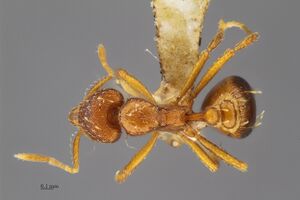 
| |
| . | Owned by Museum of Comparative Zoology. |
Images from AntWeb
   
| |
| Worker. Specimen code casent0006029. Photographer April Nobile, uploaded by California Academy of Sciences. | Owned by MCZ, Cambridge, MA, USA. |
  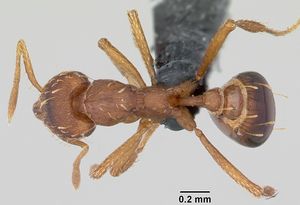 
| |
| Worker. Specimen code casent0060533. Photographer April Nobile, uploaded by California Academy of Sciences. | Owned by CAS, San Francisco, CA, USA. |
  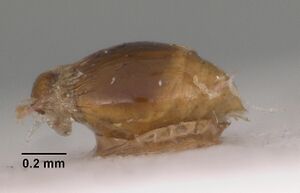   
| |
| Holotype of Strumigenys raymondi. Worker. Specimen code casent0102255. Photographer April Nobile, uploaded by California Academy of Sciences. | Owned by NHMUK, London, UK. |
      
| |
| Worker. Specimen code casent0005997. Photographer April Nobile, uploaded by California Academy of Sciences. | Owned by MCZ, Cambridge, MA, USA. |
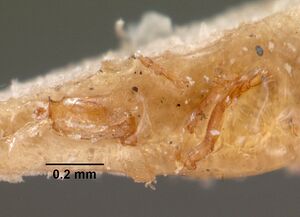 
| |
| Specimen code casent0102079. . | |
Queen
Images from AntWeb
 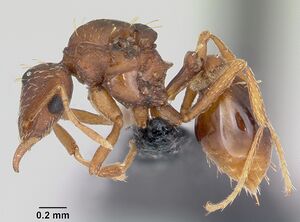  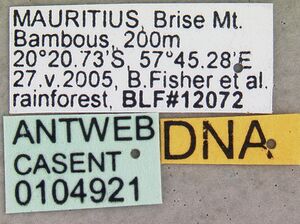
| |
| Queen (alate/dealate). Specimen code casent0104921. Photographer April Nobile, uploaded by California Academy of Sciences. | Owned by CAS, San Francisco, CA, USA. |
Nomenclature
The following information is derived from Barry Bolton's Online Catalogue of the Ants of the World.
- simoni. Strumigenys simoni Emery, 1895h: 42, pl. 2, fig. 21 (w.) SOUTH AFRICA. Combination in S. (Trichoscapa): Santschi, 1913b: 258 (in key); in S. (Cephaloxys): Wheeler, W.M. 1922a: 920; Emery, 1924d: 324; in Smithistruma (Serrastruma): Brown, 1948e: 107; in Serrastruma: Brown, 1952e: 82; in Pyramica: Bolton, 1999: 1673; in Strumigenys: Baroni Urbani & De Andrade, 2007: 128. Senior synonym of biconvexa, boerorum, cliens, cognata, escherichi, fusciventris, limbata and material of the unavailable name obscuriventris referred here: Brown, 1952e: 82; of raymondi: Bolton, 1983: 350. See also: Bolton, 2000: 318.
- escherichi. Strumigenys escherichi Forel, 1910c: 261 (w.) ETHIOPIA. Combination in S. (Trichoscapa): Santschi, 1913b: 258 (in key); in S. (Cephaloxys): Wheeler, W.M. 1922a: 919; Emery, 1924d: 324. Junior synonym of simoni: Brown, 1952e: 82.
- cognata. Strumigenys cognata Santschi, 1911c: 362 (w.q.) ANGOLA. Santschi, 1913b: 258 (q.). Combination in S. (Trichoscapa): Santschi, 1913b: 258 (in key); in S. (Cephaloxys): Wheeler, W.M. 1922a: 919. Subspecies of escherichi: Forel, 1913b: 317 (in text); Forel, 1916: 427. Junior synonym of simoni: Brown, 1952e: 82.
- biconvexa. Strumigenys (Trichoscapa) biconvexa Santschi, 1913b:258 (in key) (w.q.) KENYA. Santschi, 1914b: 111 (w.q.). Combination in S. (Cephaloxys): Wheeler, W.M. 1922a: 919. Junior synonym of simoni: Brown, 1952e: 82.
- boerorum. Strumigenys (Trichoscapa) cognata st. boerorum Santschi, 1913b: 259 (in key) (w.) SOUTH AFRICA. Santschi, 1914e: 32 (q.). Combination in S. (Cephaloxys): Wheeler, W.M. 1922a: 919. Subspecies of escherichi: Santschi, 1914e: 32. Junior synonym of simoni: Brown, 1952e: 82.
- cliens. Strumigenys escherichi var. cliens Forel, 1913b: 317 (w.) DEMOCRATIC REPUBLIC OF CONGO. Combination in S. (Cephaloxys): Wheeler, W.M. 1922a: 919. Junior synonym of simoni: Brown, 1952e: 82.
- limbata. Strumigenys escherichi r. limbata Forel, 1913j: 222 (w.) ZIMBABWE. Arnold, 1917: 382 (q.). Combination in S. (Cephaloxys): Wheeler, W.M. 1922a: 920. Junior synonym of simoni: Brown, 1952e: 82.
- fusciventris. Strumigenys (Cephaloxys) escherichi var. fusciventris Emery, 1924d: 324, (w.) NIGERIA. [First available use of Strumigenys (Trichoscapa) escherichi st. cognata var. fusciventris Santschi, 1915c: 261; unavailable name.] Junior synonym of simoni: Brown, 1952e: 82.
- raymondi. Strumigenys (Cephaloxys) raymondi Donisthorpe, 1946c: 778 (w.q.) MAURITIUS. Junior synonym of alluaudi: Brown, 1952e: 75; of simoni: Bolton, 1983: 350.
Unless otherwise noted the text for the remainder of this section is reported from the publication that includes the original description.
Description
Worker
Bolton (1983) - TL 2.4-3.0, HL 0.54-0.64, HW 0.44-0.52, CI 74-85, ML 0.20-0.22, MI 33-39, SL 0.34-0.41, SI 76-86, PW 0.28-0.36, AL 0.64-0.75 (60 measured).
Mandibular denticles small even and very regular, without an enlarged basal series but often with the basalmost denticle somewhat enlarged. Upper scrobe margins conspicuous, forming a punctulate or granular flange which extends back to the apex of the scrobe before petering out, the margins each with a single long flagellate hair arising just behind the level of the eye and projecting laterally. Clypeus sculptured on the disc, finely punctulate or granular, or sometimes feebly striate, with sparse spatulate appressed hairs. False anterior clypeal margin with a row of spatulate hairs which project forwards over the mandibular bases. Ground-pilosity of head of scattered but distinctive anteriorly directed spatulate hairs which are decumbent to appressed. Dorsum of head behind highest point of vertex with two pairs of stout standing hairs which are anteriorly curved and apically clavate. Dorsum of head densely reticulate-punctate. Pronotum not marginate laterally, the pronotum and anterior portion of mesonotum convex and on a higher level than the propodeum, the posterior portion of the mesonotum sloping steeply down to the metanotal groove which is broadly and shallowly impressed. Propodeal dorsum shallowly convex, the teeth usually broad and strongly developed, with a conspicuous infradental lamella. Alitrunk pleurae smooth, devoid of sculpture or at most with punctulate vestiges peripherally. Sides of pronotum usually smooth but sometimes with one or two striae which extend onto the sides from the dorsum. Sculpture of pronotal dorsum variable, ranging from almost smooth with only vestiges of sculpture to quite strongly sculptured. Commonly the sculpture consists of few to several longitudinal to oblique fine costulae or striae on an almost or quite smooth surface. Variation away from this occurs either by reduction in number and intensity of the costulae or striae until the dorsum is almost unsculptured, or by intensification of the costulae or striae, or by the appearance of fine punctulation between them. However, in samples where punctulate sculpture occurs it is always very obviously secondary to the costulate or striate component, and in samples where the pronotum is smooth a median fine longitudinal carinula usually remains. Dorsal surfaces of mesonotum and propodeum finely and densely reticulate-punctate, as is the upper portion of the propodeal declivity between the teeth. Pronotum equipped at the humeri with a pair of long fine flagellate hairs, the mesonotum with a pair of stout curved hairs which which are clavate apically. Ground-pilosity of promesonotum consisting of a few scattered narrowly spatulate hairs which are appressed or nearly so. Spongiform appendages of pedicel segments well developed in profile, the subpetiolar appendage running the length of the segment; the ventral and lateral spongiform lobes of the postpetiole large, the former usually somewhat larger than the latter. Petiole node in dorsal view finely reticulate-punctate, the sculpture sometimes faint, broader than long and with a conspicuous posterior collar of spongiform material. Postpetiole smooth dorsally, with spongiform material posterolaterally and with a broad posterior strip. Base of first gastral tergite bordered with a lamellate strip upon which the basigastral costulae arise and run posteriorly for a short distance on the tergite proper. Petiole and postpetiole each with a single pair of stout hairs which are clavate apically, the first gastral tergite with 1-8 pairs of such hairs. Colour ranging from yellowish brown to blackish brown.
Type Material
Bolton (1983) - Holotype worker, SOUTH AFRICA: Transvaal, Makapan, 1893 (E. Simon). (Museo Civico di Storia Naturale, Genoa) [examined].
References
- Baroni Urbani, C. & De Andrade, M.L. 2007. The ant tribe Dacetini: limits and constituent genera, with descriptions of new species. Annali del Museo Civico di Storia Naturale “G. Doria” 99: 1-191.
- Bolton, B. 1983. The Afrotropical dacetine ants (Formicidae). Bulletin of the British Museum (Natural History). Entomology 46:267-416. (page 350, senior synonym of raymondi)
- Bolton, B. 1999. Ant genera of the tribe Dacetonini (Hymenoptera: Formicidae). J. Nat. Hist. 3 33: 1639-1689 (page 1673, combination in Pyramica)
- Bolton, B. 2000. The ant tribe Dacetini. Memoirs of the American Entomological Institute. 65:1-1028. (page 318, figs. 210, 233 redescription of worker)
- Brown, W. L., Jr. 1948e. A preliminary generic revision of the higher Dacetini (Hymenoptera: Formicidae). Trans. Am. Entomol. Soc. 74: 101-129 (page 107, Combination in Smithistruma (Serrastruma))
- Brown, W. L., Jr. 1952h. Revision of the ant genus Serrastruma. Bulletin of the Museum of Comparative Zoology 107: 67-86. (page 82, Combination in Serrastruma, senior synonym of biconvexa, boerorum, cliens, cognata, escherichi, fusiventris and limbata, and material of the unavailable name obscuriventris referred here.)
- Emery, C. 1895g. Mission scientifique de M. Ch. Alluaud dans le territoire de Diego-Suarez (Madagascar-nord) (Avril-août 1893). Formicides. Ann. Soc. Entomol. Belg. 39: 336-345 (page 42, pl. 2, fig. 21 worker described)
- Santschi, F. 1913b. Clé analytique des fourmis africaines du genre Strumigenys Sm. (Hym.). Bull. Soc. Entomol. Fr. 1913: 257-259 (page 258, Combination in S. (Trichoscapa))
- Wheeler, W. M. 1922j. Ants of the American Museum Congo expedition. A contribution to the myrmecology of Africa. VIII. A synonymic list of the ants of the Ethiopian region. Bull. Am. Mus. Nat. Hist. 45: 711-1004 (page 920, Combination in S. (Cephaloxys))
References based on Global Ant Biodiversity Informatics
- Arnold G. 1917. A monograph of the Formicidae of South Africa. Part III. Myrmicinae. Annals of the South African Museum. 14: 271-402.
- Bernard F. 1953. La réserve naturelle intégrale du Mt Nimba. XI. Hyménoptères Formicidae. Mémoires de l'Institut Français d'Afrique Noire 19: 165-270.
- Bolton B. 1983. The Afrotropical dacetine ants (Formicidae). Bulletin of the British Museum (Natural History). Entomology 46: 267-416.
- Bolton, B. 2000. The Ant Tribe Dacetini. Memoirs of the American Entomological Institute 65
- Brown W. L., Jr. 1952. Revision of the ant genus Serrastruma. Bulletin of the Museum of Comparative Zoology 107: 67-86.
- Garcia F.H., Wiesel E. and Fischer G. 2013.The Ants of Kenya (Hymenoptera: Formicidae)Faunal Overview, First Species Checklist, Bibliography, Accounts for All Genera, and Discussion on Taxonomy and Zoogeography. Journal of East African Natural History, 101(2): 127-222
- IZIKO South Africa Museum Collection
- Madl M. 2019. Notes on the ant fauna of Eritrea (Insecta: Hymenoptera: Formicidae): type specimens deposited in the Natural History Museum Vienna (Austria) and a preliminary checklist. Ann. Naturhist. Mus. Wien, B 121: 9-18.
- Santschi F. 1913. Clé analytique des fourmis africaines du genre Strumigenys Sm. (Hym.). Bulletin de la Société Entomologique de France 1913: 257-259.
- Santschi F. 1914. Formicides de l'Afrique occidentale et australe du voyage de Mr. le Professeur F. Silvestri. Bollettino del Laboratorio di Zoologia Generale e Agraria della Reale Scuola Superiore d'Agricoltura. Portici 8: 309-385.
- Santschi F. 1937. Résultats de la Mission scientifique suisse en Angola (2me voyage) 1932-1933. Fourmis angolaises. Revue Suisse de Zoologie. 44: 211-250.
- Wheeler W. M. 1922. Ants of the American Museum Congo expedition. A contribution to the myrmecology of Africa. VIII. A synonymic list of the ants of the Ethiopian region. Bulletin of the American Museum of Natural History 45: 711-1004

